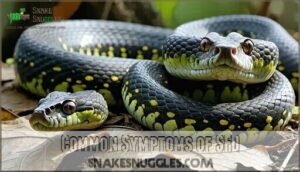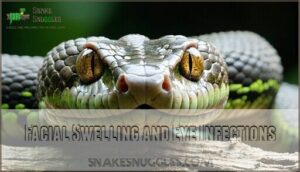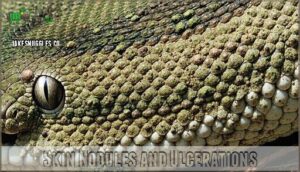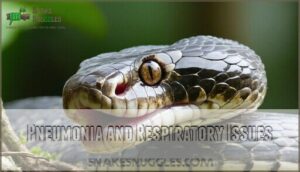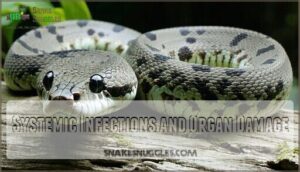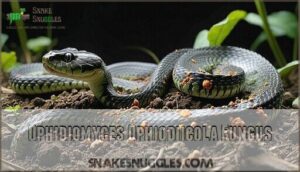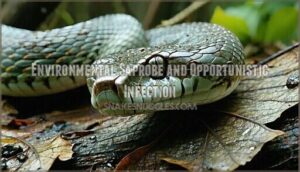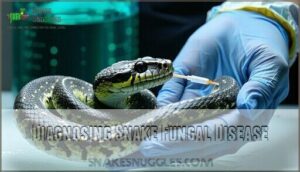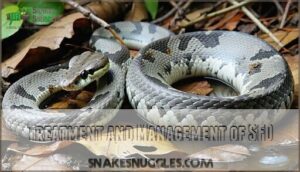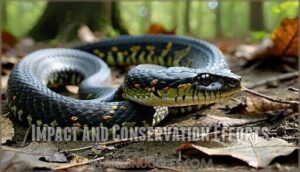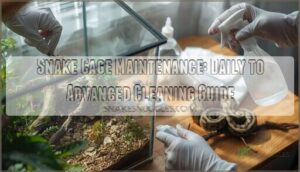This site is supported by our readers. We may earn a commission, at no cost to you, if you purchase through links.

Look for thick, crusty skin lesions that appear white, yellow, or brown, often starting on the face or belly. Your snake may develop facial swelling, cloudy or infected eyes, and raised nodules or ulcerations on their skin.
Respiratory symptoms like mouth breathing or wheezing can indicate the infection has spread to their lungs.
Advanced cases show systemic effects including lethargy, poor appetite, and difficulty shedding. The disease progresses gradually, so early detection gives you the best chance for successful intervention and proper veterinary care.
Table Of Contents
- Key Takeaways
- Identifying Snake Fungal Disease
- Causes and Transmission of SFD
- Diagnosing Snake Fungal Disease
- Treatment and Management of SFD
- Impact and Conservation Efforts
- Frequently Asked Questions (FAQs)
- What are the symptoms of snake fungal disease?
- Can snake fungal disease be cured?
- What are the symptoms of a fungal disease?
- How contagious is snake fungal disease?
- Is snake fungal disease treatable?
- What is the mortality rate for snake fungal disease?
- How do you treat fungal disease in snake plants?
- What is antifungal treatment for snakes?
- How does SFD affect snake behavior and movement?
- What ecosystems are most at risk from SFD?
- Conclusion
Key Takeaways
- Watch for distinctive skin changes – You’ll spot thick, crusty lesions that appear white, yellow, or brown, often starting on your snake’s face or belly, plus raised nodules and ulcerations on the skin.
- Monitor facial and eye symptoms – Look out for facial swelling, cloudy or infected eyes, and the telltale "black eye" appearance that can lead to vision problems and breathing difficulties.
- Recognize respiratory warning signs – You’ll notice mouth breathing, wheezing, or gasping that indicates the infection has spread to your snake’s lungs, requiring immediate attention.
- Seek veterinary care immediately – Don’t wait if you see these symptoms, as early detection gives you the best chance for successful treatment, while advanced cases can lead to organ failure and death.
Identifying Snake Fungal Disease
You’ll need to recognize snake fungal disease early to protect your pet’s health and prevent serious complications.
This devastating infection shows distinct warning signs that progress from mild skin changes to life-threatening systemic disease if left untreated, which can lead to serious complications.
Early detection saves lives—watch for skin lesions, cloudy eyes, and breathing difficulties before it’s too late.
Common Symptoms of SFD
Your snake’s health depends on recognizing SFD symptoms early, when treatment can still make a difference.
Watch for these critical warning signs that demand immediate veterinary attention:
- Skin lesions – thickened, crusted, or discolored scales covering the body
- Cloudy eyes – opaque or milky appearance indicating infection spread
- Lethargy – unusual reluctance to move or decreased activity levels
- Emaciation – visible weight loss despite normal feeding schedules
Facial Swelling and Eye Infections
Watch for the telltale "black eye" appearance when your snake’s face becomes swollen, creating significant vision impairment that affects feeding and daily activities.
Swelling severity around facial areas often progresses to disfiguring facial lesions, while cloudy eyes indicate serious infection. A swollen snake face signals breathing difficulties, potentially leading to blindness risk without prompt treatment.
Addressing a potential snake eye infection promptly is essential to prevent further complications, making it a critical requirement for snake care.
Skin Nodules and Ulcerations
You might spot one or more skin nodules or ulcerations—these aren’t just cosmetic hiccups. They’re classic signs of snake fungal disease, and ignoring them can lead to bigger problems.
Here’s what to look for:
- Nodule Development along the body
- Ulceration Severity increasing over time
- Scale Damage and crusted scales
- Deeper Tissue Invasion
- Risk of Secondary Infections
Snakes may develop issues like ulcerative dermatitis from fungal infections. This can be a serious condition, leading to bigger problems if not addressed properly, and may result in secondary infections.
Pneumonia and Respiratory Issues
After seeing skin nodules, keep an eye out for breathing issues—these can mean more than just a lazy day.
Pneumonia symptoms like labored breathing or open-mouth gasping may point to pulmonary SFD. Here’s what to watch for:
- Wheezing or respiratory distress
- Sudden breathing difficulty
- Lethargy and inactivity
- Signs of lung damage
- Higher mortality rates in advanced cases
Systemic effects can sneak up fast, so act quickly to address breathing issues and prevent lung damage.
Systemic Infections and Organ Damage
Beyond respiratory problems lies a more serious concern: systemic infections can spread throughout your snake’s body.
When deep tissue invasion occurs, the fungus attacks muscles, bones, and essential organs, causing liver damage and lung compromise.
Deep tissue invasion means the fungus isn’t just skin deep—it’s targeting vital organs and threatening your snake’s life.
Muscle invasion and bone involvement create severe complications, while systemic progression often leads to organ failure and death.
Mortality rates climb dramatically once internal organs become compromised.
| Affected System | Damage Type |
|---|---|
| Respiratory | Lung compromise, pneumonia |
| Hepatic | Liver damage, organ failure |
| Musculoskeletal | Muscle invasion, bone involvement |
| Circulatory | Systemic progression throughout body |
| Overall Health | Increased mortality rates |
Causes and Transmission of SFD
You’re dealing with a fungus called Ophidiomyces ophiodiicola that thrives in soil and moisture, making it a persistent environmental threat to your snake.
This opportunistic pathogen spreads through contaminated surfaces, soil particles tracked on shoes or equipment, and direct contact between infected animals.
With ideal growth occurring in specific temperature and pH conditions that many snake habitats naturally provide, it poses a significant risk, particularly in environments where these conditions are met, allowing for the fungus to spread and infect snakes, highlighting the importance of environmental threat.
Ophidiomyces Ophiodiicola Fungus
The Ophidiomyces ophiodiicola fungus represents the primary pathogen behind snake fungal disease, accounting for over 98% of confirmed SFD cases.
This fungal organism belongs to the order Onygenales and demonstrates remarkable genetic diversity across different geographic regions.
The pathogen’s virulence factors enable it to penetrate healthy snake skin, creating characteristic skin lesions that serve as clinical signs of infection.
SFD can spread through contaminated soil.
- Fungus taxonomy: Classified within Onygenales, this species shows distinct genetic markers
- Environmental survival: Persists in soil and substrates for extended periods between hosts
- Growth requirements: Thrives in warm, humid conditions with specific pH ranges
- Snake disease signs: Manifests through distinctive crusty, thickened skin lesions and nodules
Environmental Saprobe and Opportunistic Infection
Ophidiomyces ophiodiicola thrives as a saprobic lifestyle organism, feeding on decaying matter in soil reservoirs.
This fungal persistence creates constant environmental triggers for opportunistic infection.
When your snake’s host immunity weakens from stress, poor conditions, or illness, the ever-present fungus seizes the moment.
These infection triggers transform a normally harmless environmental resident into a deadly threat, making snake fungal disease prevention your top priority.
Contaminated Soil and Human Tracking
Soil contamination presents a hidden pathway for snake fungal disease transmission, with humans unknowingly serving as carriers.
The Ophidiomyces ophiodiicola fungus demonstrates remarkable environmental persistence, surviving in contaminated soil for extended periods.
You can inadvertently transport infected material between habitats through:
- Unwashed hiking boots and field equipment
- Vehicle tires carrying contaminated substrate
- Research tools moved between study sites
- Clothing and gear exposed to infected environments.
Human spread amplifies the natural transmission rate substantially, making decontamination methods essential for wildlife protection.
Temperature and PH Levels Affecting Fungal Growth
While tracking in contaminated soil is a concern, don’t overlook how temperature and pH levels shape the battlefield for Ophidiomyces ophiodiicola.
Warmer temperatures and a wide pH range create ideal conditions for fungal growth, boosting the Growth Rate and Environmental Impact of Snake Fungal Disease.
Think of it as the fungus throwing a garden party—except your snakes aren’t invited.
Diagnosing Snake Fungal Disease
When you suspect snake fungal disease, you’ll need more than a magnifying glass and a hunch—diagnosing SFD relies on careful observation, laboratory tests, and sometimes a bit of patience.
Accurate identification of the fungus, often through skin biopsies and DNA analysis, is the key to guiding effective treatment and protecting your snake’s health.
Laboratory Confirmation Methods
When you suspect snake fungal disease, your vet will need laboratory confirmation to nail down the diagnosis.
Fungal culture grows the Ophidiomyces ophiodiicola organism from tissue samples, while PCR testing detects the fungus’s DNA sequencing markers with pinpoint accuracy.
Histopathology examines infected tissue under a microscope, and biopsy analysis reveals cellular changes that confirm infection.
These diagnostic tools work together, giving your vet the complete picture needed for proper treatment planning.
Skin Lesions and Biopsy Examination
When examining snake skin lesions, veterinarians use specialized biopsy techniques to achieve accurate fungal identification.
The histopathological examination reveals vital lesion morphology patterns that confirm infection presence.
- **Sample collection involves removing affected tissue from the lesion site using sterile instruments, ensuring proper preservation for detailed microscopic analysis.
This diagnostic accuracy depends on proper biopsy techniques and thorough histopathology findings evaluation.
Fungal Culture and DNA Detection
Laboratory culture and DNA sequencing provide definitive snake fungal diagnosis through advanced molecular techniques.
Laboratory tests, such as culture sensitivity, allow researchers to isolate Ophidiomyces ophiodiicola from skin samples, though this method requires weeks for results.
PCR specificity offers faster identification by detecting unique genetic markers in the pathogen’s DNA, and environmental sampling from contaminated substrates can reveal fungal presence before clinical signs appear.
These laboratory tests work together—culture confirms viability while PCR delivers rapid molecular confirmation, and DNA sequencing validates species identification with remarkable accuracy.
This integrated approach supports both individual treatment decisions and broader conservation efforts targeting affected populations.
Histopathological Examination and RtPCR/qPCR
Advanced histopathology reveals tissue changes that confirm SFD diagnosis.
When combined with molecular techniques, you’ll get definitive results through thorough analysis:
- PCR and qPCR detect Ophidiomyces ophiodiicola DNA with high sensitivity
- Histopathology specificity identifies characteristic fungal structures in tissue samples
- Lesion correlation links clinical signs to microscopic findings
- Diagnostic accuracy improves when combining both methods for reliable confirmation
The combination of these methods provides a comprehensive approach to diagnosis.
Treatment and Management of SFD
Once you’ve diagnosed snake fungal disease, treatment becomes a challenging journey requiring patience and specialized veterinary care.
While antifungal medications show promise, success rates remain frustratingly inconsistent, making supportive care and prevention equally important for your snake’s recovery.
Antifungal Medications and Limited Success
Current antifungal medications for snake fungal disease show limited effectiveness.
Itraconazole efficacy varies substantially, while voriconazole alternatives face dosage challenges and potential toxicity in certain species.
Resistance development complicates treatment duration, often requiring multiple courses, and single-agent antifungal treatments rarely achieve complete resolution, even after extended therapy.
Snake fungal disease was first detected in the UK in 2015, and these medications work best in captive settings where prolonged monitoring is possible, particularly for effective treatment.
Supportive Care and Wound Management
How do you support a snake battling fungal disease when medications fall short? Supportive care becomes your lifeline. Proper Hydration Strategies, Temperature Control, and Nutritional Support create healing conditions, while careful Lesion Cleaning and Bandaging Techniques protect damaged tissue from secondary infections.
- Thermal support maintains ideal body temperature for immune function and antifungal treatment effectiveness
- Wound management involves gentle cleaning of skin lesions, scabs, and ulcerated scales with antiseptic solutions
- Fluid therapy prevents dehydration while nutritional support strengthens recovery from systemic infections
Many owners find specialized antifungal products beneficial during this stage.
Preventive Measures and Responsible Handling
Beyond managing infections, prevention requires dedicated effort.
Implement disinfection protocols using 3% bleach for equipment between snake encounters. Practice habitat sanitation by removing organic debris that harbors fungi.
Minimize disturbance in wild populations to reduce stress-related susceptibility. Support public education initiatives about snake fungal disease recognition.
When relocating snakes, follow safe relocation guidelines to prevent spreading contamination between populations.
The disease is caused by Ophidiomyces ophiodiicola fungus.
Ongoing Research and Future Directions
Multiple clinical trials testing antifungal regimens are advancing treatment development for snake fungal disease, while researchers investigate transmission mechanisms and environmental factors contributing to outbreaks.
Scientists are developing rapid field diagnostics and studying resistance patterns to improve therapeutic outcomes. Predictive modeling helps forecast outbreak risks, and emerging probiotic solutions show promise for wildlife health.
These collaborative efforts between herpetologists and veterinarians are essential for effective snake conservation and disease transmission control through enhanced monitoring programs.
Impact and Conservation Efforts
Snake fungal disease doesn’t just affect individual animals—it’s reshaping entire ecosystems across North America.
You’ll discover how this emerging threat is driving conservation efforts and why your observations could help scientists protect vulnerable species.
Geographic Distribution and Affected Species
Snake Fungal Disease affects over 30 snake species across 26 U.S. states, Puerto Rico, and Ontario, Canada.
Species Susceptibility varies, with Viperidae and Colubridae families showing higher Regional Prevalence.
Geographic distribution spans eastern United States primarily, though Expansion Factors include environmental conditions and human activity.
Habitat Influence plays a pivotal role in transmission rates, and Conservation Implications remain significant for vulnerable snake species populations.
Research indicates that the majority of SFD cases are concentrated in the United States.
Declines in Rattlesnake Populations
A tough reality—rattlesnake SFD impact is real, with conservation challenges stacking up.
Snake fungal disease isn’t picky, hitting even rare species and causing sharp declines.
Watch for:
- Habitat loss shrinking safe spaces
- Genetic diversity dropping, making rebounds tough
- Population modeling revealing alarming trends
- Snake mortality rising, with behavior changes like snake lethargy complicating recovery
Rattlesnakes are absent from certain US states, impacting conservation strategies.
Nature’s warning rattle is getting quieter, signaling a need for urgent action to address snake mortality.
Conservation Strategies and Awareness
Population declines among rattlesnakes highlight why conservation strategies matter.
Habitat preservation protects critical microclimates that support snake populations recovering from snake fungal disease.
Public education campaigns teach proper disinfection protocols, preventing contamination spread.
Wildlife agencies need policy changes supporting habitat management and research funding.
Disease monitoring through citizen science projects tracks outbreaks, while responsible captive breeding programs avoid releasing potentially infected animals into wild populations.
Reporting SFD Cases and Research Contributions
By reporting suspected snake fungal disease cases to state wildlife agencies and research organizations, you’re contributing essential data collection that supports collaborative studies.
Your observations help researchers track disease patterns, secure research funding, and develop better monitoring protocols.
The USGS relies on citizen science reports for early recognition of outbreaks, ultimately protecting snake populations and public health through enhanced surveillance efforts.
Frequently Asked Questions (FAQs)
What are the symptoms of snake fungal disease?
Looking at over 95% of infected snakes is like examining battle scars on weathered armor.
You’ll notice thickened, crusted skin lesions, facial swelling, cloudy eyes, lumps under skin, and lethargy indicating fungal invasion.
Can snake fungal disease be cured?
Snake fungal disease can’t be fully cured, but you can treat it with antifungal medications like itraconazole and voriconazole.
Treatment success varies substantially, and early detection greatly improves your snake’s chances of recovery and survival.
What are the symptoms of a fungal disease?
You’ll notice thickened, crusty, or discolored skin patches on infected snakes, along with facial swelling, cloudy eyes, and unusual lumps beneath the skin, creating concerning changes in appearance.
How contagious is snake fungal disease?
Snake fungal disease spreads through direct contact with infected snakes, contaminated surfaces, soil, or water.
You’ll find the fungus survives in environments for extended periods, making transmission relatively easy between snakes sharing habitats.
Is snake fungal disease treatable?
Think it’s impossible to battle a fungus tougher than a two-dollar steak.
Actually, you can treat snake fungal disease with antifungal meds and good care, but success isn’t guaranteed.
Early diagnosis and expert help give you the best shot.
What is the mortality rate for snake fungal disease?
You’ll find that mortality rates for snake fungal disease can top 50% in untreated wild populations, especially during outbreaks.
It’s a tough break—early detection and care are key if you want snakes to beat the odds.
How do you treat fungal disease in snake plants?
To treat fungal disease in snake plants, remove affected leaves, let the soil dry out, and apply a fungicide labeled for houseplants.
Good airflow and less water are your best friends—don’t drown your plant in kindness!
What is antifungal treatment for snakes?
Fungal foes frustrate snake keepers, but you’ll fight back with antifungals like itraconazole or voriconazole, plus wound care, fluids, and warmth.
Early action is key—don’t wait for scales to start looking like a bad patchwork quilt, and remember to use antifungals as part of your treatment approach.
How does SFD affect snake behavior and movement?
SFD severely impacts snake behavior by causing unusual lethargy and reluctance to move in 80% of cases.
You’ll notice infected snakes become less active, struggle with hunting due to facial disfigurement, and exhibit increased mouth breathing.
What ecosystems are most at risk from SFD?
Eastern ecosystems, woodland habitats, and wetland environments face highest risk.
You’ll find SFD spreads rapidly through dense snake populations in forests, swamps, and grasslands where moisture and temperature create ideal fungal conditions.
Conclusion
Did you know over 30% of wild snake populations in some regions show signs of snake fungal disease?
This fact highlights why it’s essential to spot the warning signs early—thick skin lesions, facial swelling, and changes in behavior.
If you notice these symptoms, don’t wait; seek veterinary care and follow strict hygiene.
By staying alert and informed, you’ll help protect your snake and contribute to broader efforts against this serious threat to reptile health.
- https://en.wikipedia.org/wiki/Polymerase_chain_reaction
- https://pubs.er.usgs.gov/publication/fs20173064
- https://www.sciencedirect.com/topics/immunology-and-microbiology/onygenales
- https://pubmed.ncbi.nlm.nih.gov/38251998/
- https://www.gardenwildlifehealth.org/wp-content/uploads/sites/12/2022/10/Reptile-SFD_GWH_updated.pdf

